Effects of Discharge Area and Atomizing Gas Type in Full Cone Twin-Fluid Atomizer on Extinguishing Performance of Heptane Pool Fire under Two Heat Release Rate Conditions in an Enclosed Chamber
Featured Application
Abstract
1. Introduction
2. Experimental Details
2.1. Experimental Setup for Fire Extinguishment
2.2. Full Cone Twin-Fluid Atomizer
2.3. Heptane Pool Fire Source
2.4. Experimental Procedure for Fire Extinguishment
3. Results and Discussion
3.1. Droplet Size of Water Mist in Twin-Fluid Atomizer
3.2. Influence of Discharge Area
3.2.1. Extinguishing Time
3.2.2. Peak Surface Temperature
3.2.3. Minimum Oxygen Concentration
3.2.4. Comparison between Large and Small Atomizers
3.3. Influence of Atomizing Gas Type
3.3.1. Extinguishing Time
3.3.2. Peak Surface Temperature
3.3.3. Minimum Oxygen Concentration
3.3.4. Comparison between Nitrogen and Air
4. Conclusions
- (1)
- With respect to the droplet size of the water mist, as the water and air flow rates decreased and increased, respectively, the droplet sizes of the water mist decreased. The SMD of large and small atomizers were in the range of approximately 12–60 and 12–49 μm, respectively. The SMD of the large atomizer was larger than that of the small atomizer. This is due to the fact that the discharge velocities of the atomizing gas in the large atomizer were reduced and the energy required to atomize the liquid decreased owing to its large annular gap area.
- (2)
- Increases in extinguishing times resulted in increasing the peak surface temperatures and decreasing the minimum oxygen concentrations.
- (3)
- With respect to the discharge area effect, the large atomizer exhibited longer extinguishing times, higher peak surface temperatures, and lower minimum oxygen concentrations than the small atomizer. One of the reasons for these trends is that the small atomizer with a small discharge area showed the higher velocity of the discharged flow and smaller droplet size of the water mist. This can lead to shortening of the extinguishing time, cooling of the flame and fuel surface, and preventing of fuel vapor retention in the reaction region. Additionally, the effect of the discharge area on fire-extinguishing performance was dominant under certain flow rate conditions.
- (4)
- With respect to the atomizing gas type effect, under the most flow rate conditions, the nitrogen and air appeared to show nearly similar extinguishing time, peak surface temperatures, and minimum oxygen concentrations. In the present study, water mist and atomizing gas were discharged directly and intensively into the fire source. Hence, heat extraction (i.e., cooling) of discharged water mist and atomizing gas can be a predominant fire-extinguishing mechanism wherein the effect of the atomizing gas type becomes small. Based on the present and previous studies, it was observed that the effect of the atomizing gas type on the fire-extinguishing performance is dependent on the relative positions of the discharged flow (i.e., water mist and atomizing gas) and fire source.
Author Contributions
Funding
Institutional Review Board Statement
Informed Consent Statement
Data Availability Statement
Acknowledgments
Conflicts of Interest
References
- Liu, Z.; Kim, A.K. A Review of Water Mist Fire Suppression Systems-Fundamental Studies. J. Fire Prot. Eng. 1999, 10, 32–50. [Google Scholar]
- Society of Fire Protection Engineers. SFPE Handbook of Fire Protection Engineering, 5th ed.; Springer: New York, NY, USA, 2016. [Google Scholar]
- Wang, L.; Liu, Z.; Chen, S.; Zheng, C.; Li, J. Physical and Chemical Effects of CO2 and H2O Additives on Counterflow Diffusion Flame Burning Methane. Energy Fuels 2013, 27, 7602–7611. [Google Scholar] [CrossRef]
- Filho, F.L.S.; de Albuquerque Paixão e Freire de Carvalho, L.E.; van Oijen, J.A.; Krieger Filho, G.C. Effects of Reaction Mechanisms and Differential Diffusion in Oxy-Fuel Combustion Including Liquid Water Dilution. Fluids 2021, 6, 47. [Google Scholar] [CrossRef]
- Liu, Z.; Kim, A.K.; Carpenter, D. A Study of Portable Water Mist Fire Extinguishers Used for Extinguishment of Multiple Fire Types. Fire Saf. J. 2007, 42, 25–42. [Google Scholar] [CrossRef]
- Liang, T.; Liu, M.; Liu, Z.; Zhong, W.; Xiao, X.; Lo, S. A Study of the Probability Distribution of Pool Fire Extinguishing Times Using Water Mist. Process Saf. Environ. Prot. 2015, 93, 240–248. [Google Scholar] [CrossRef]
- Yuan, L.; Lazzara, C.P. The Effects of Ventilation and Preburn Time on Water Mist Extinguishing of Diesel Fuel Pool Fires. J. Fire Sci. 2004, 22, 379–404. [Google Scholar] [CrossRef]
- Wang, X.; Liao, G.; Qin, J.; Fan, W. Experimental Study on the Effectiveness of the Extinction of a Pool Fire with Water Mist. J. Fire Sci. 2002, 20, 279–295. [Google Scholar] [CrossRef]
- Yao, B.; Cong, B.H.; Qin, J.; Chow, W.K. Experimental Study of Suppressing Poly(methyl methacrylate) Fires Using Water Mists. Fire Saf. J. 2012, 47, 32–39. [Google Scholar] [CrossRef]
- Liu, Y.; Jiang, Z.; Wang, D.; Li, X. Experimental Research on the Water Mist Fire Suppression Performance in an Enclosed Space by Changing the Characteristics of Nozzles. Exp. Therm. Fluid Sci. 2014, 52, 174–181. [Google Scholar] [CrossRef]
- Ndubizu, C.C.; Ananth, R.; Tatem, P.A. The Effects of Droplet Size and Injection Orientation on Water Mist Suppression of Low and High Boiling Point Liquid Pool Fires. Combust. Sci. Technol. 2000, 157, 63–86. [Google Scholar] [CrossRef]
- Zhou, X.; Liao, G.; Cai, B. Improvement of Water Mist’s Fire-extinguishing Efficiency with MC Additive. Fire Saf. J. 2006, 41, 39–45. [Google Scholar] [CrossRef]
- Cong, B.; Liao, G. Experimental Studies on Water Mist Suppression of Liquid Fires with and without Additives. J. Fire Sci. 2009, 27, 101–123. [Google Scholar] [CrossRef]
- Zhang, T.W.; Han, Z.Y.; Du, Z.M.; Liu, K.; Zhang, Z.L. Cooling Characteristics of Cooking Oil Using Water Mist during Fire Extinguishment. Appl. Therm. Eng. 2016, 107, 863–869. [Google Scholar] [CrossRef]
- Kim, M.B.; Jang, Y.J.; Kim, J.K. Burning Rate of a Pool Fire with Downward-directed Sprays. Fire Saf. J. 1996, 27, 37–48. [Google Scholar] [CrossRef]
- Kim, M.B.; Jang, Y.J.; Yoon, M.O. Extinction Limit of a Pool Fire with a Water Mist. Fire Saf. J. 1997, 28, 295–306. [Google Scholar] [CrossRef]
- Kim, S.C.; Ryou, H.S. The Effect of Water Mist on Burning Rates of Pool Fire. J. Fire Sci. 2004, 22, 305–323. [Google Scholar] [CrossRef]
- Mawhinney, J.R.; Dlugogorski, B.Z.; Kim, A.K. A Closer Look at the Fire Extinguishing Properties of Water Mist. Fire Saf. Sci. 1994, 4, 47–60. [Google Scholar] [CrossRef]
- Mawhinney, J.R.; Richardson, J.K. A Review of Water Mist Fire Suppression Research and Development. Fire Technol. 1996, 33, 54–90. [Google Scholar] [CrossRef]
- Grant, G.; Brenton, J.; Drysdale, D. Fire Suppression by Water Sprays. Prog. Energy Combust. Sci. 2000, 26, 79–130. [Google Scholar] [CrossRef]
- Santangelo, P.E.; Tartarini, P. Fire Control and Suppression by Water-Mist Systems. Open Thermodyn. J. 2010, 4, 167–184. [Google Scholar] [CrossRef]
- Zhu, N. Review on water mist fire suppression system. Int. J. Eng. Perform. Based Fire Codes 2003, 5, 170–175. [Google Scholar]
- Lefebvre, A.H.; McDonell, V.G. Atomization and Sprays, 2nd ed.; CRC Press: Boca Raton, FL, USA, 2017. [Google Scholar]
- Liu, Z.; Kim, A.K.; Su, J.Z. Examination of Performance of Water Mist Fire Suppression Systems under Ventilation Conditions. J. Fire Prot. Eng. 2001, 11, 164–193. [Google Scholar] [CrossRef]
- Liu, Z.; Kim, A.K.; Su, J.Z. Examination of the Extinguishment Performance of a Water Mist System Using Continuous and Cycling Discharges. Fire Technol. 1999, 35, 336–361. [Google Scholar] [CrossRef]
- Lal, S.; Gupta, M.; Kushari, A.; Kapoor, J.C.; Maji, S. Suppression of Pool Fire in a Large Enclosure with Water Mist. Int. J. Spray Combust. Dyn. 2013, 5, 181–200. [Google Scholar] [CrossRef]
- Gupta, M.; Pasi, A.; Ray, A.; Kale, S.R. An Experimental Study of the Effects of Water Mist Characteristics on Pool Fire Suppression. Exp. Therm. Fluid Sci. 2013, 44, 768–778. [Google Scholar] [CrossRef]
- Jeong, C.S.; Lee, C.Y. Experimental Investigation on Spray Characteristics of Twin-Fluid Nozzle for Water Mist and its Heptane Pool Fire Extinguishing Performance. Process Saf. Environ. Prot. 2021, 148C, 724–736. [Google Scholar] [CrossRef]
- Gupta, M.; Rajora, R.; Sahai, S.; Shankar, R.; Ray, A.; Kale, S.R. Experimental Evaluation of Fire Suppression Characteristics of Twin Fluid Water Mist System. Fire Saf. J. 2012, 54, 130–142. [Google Scholar] [CrossRef]
- Yuan, M.; Chen, B.; Li, C.; Zhang, J.; Lu, S. Analysis of the Combustion Efficiencies and Heat Release Rates of Pool Fires in Ceiling Vented Compartments. Procedia Eng. 2013, 62, 275–282. [Google Scholar] [CrossRef]
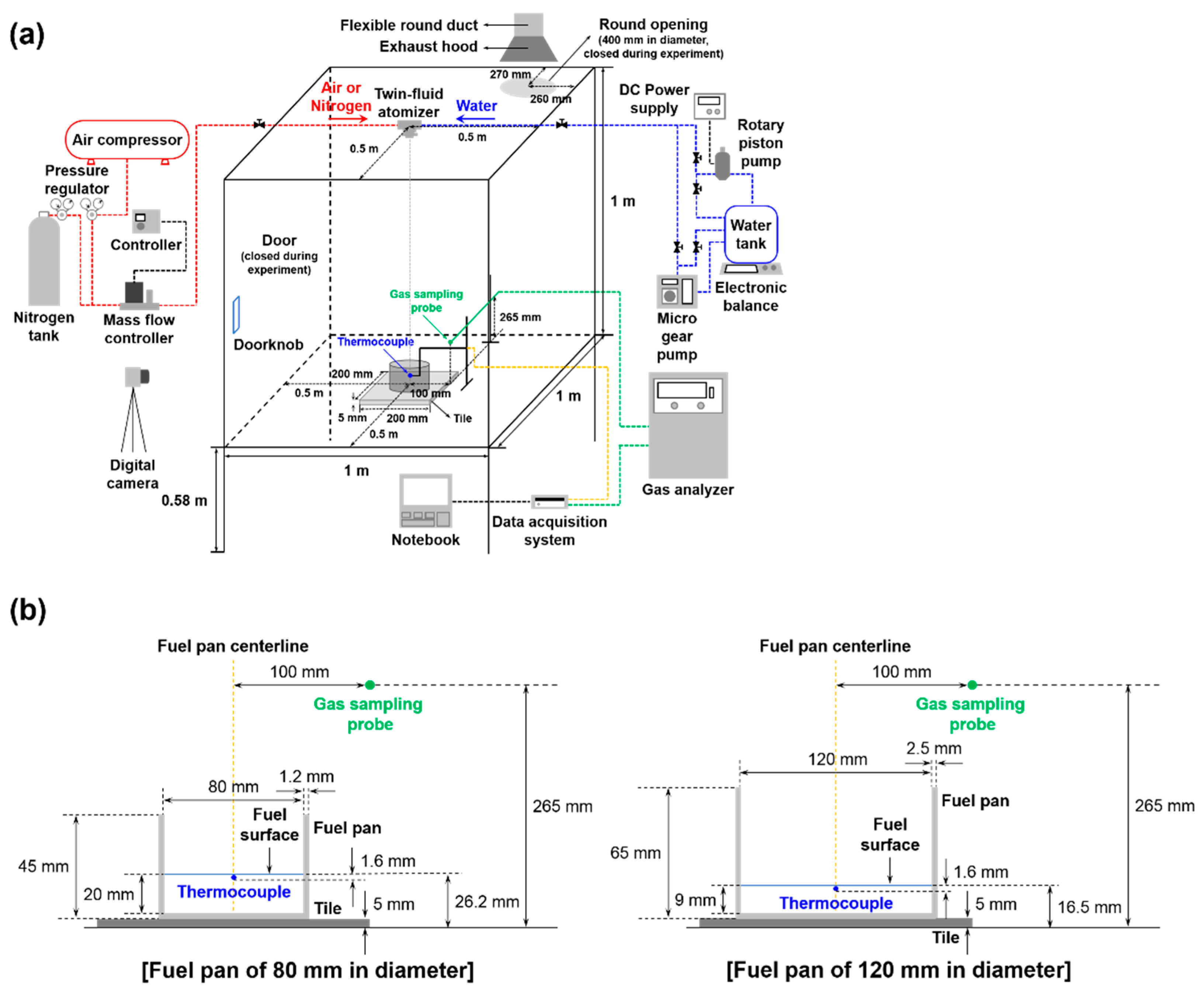

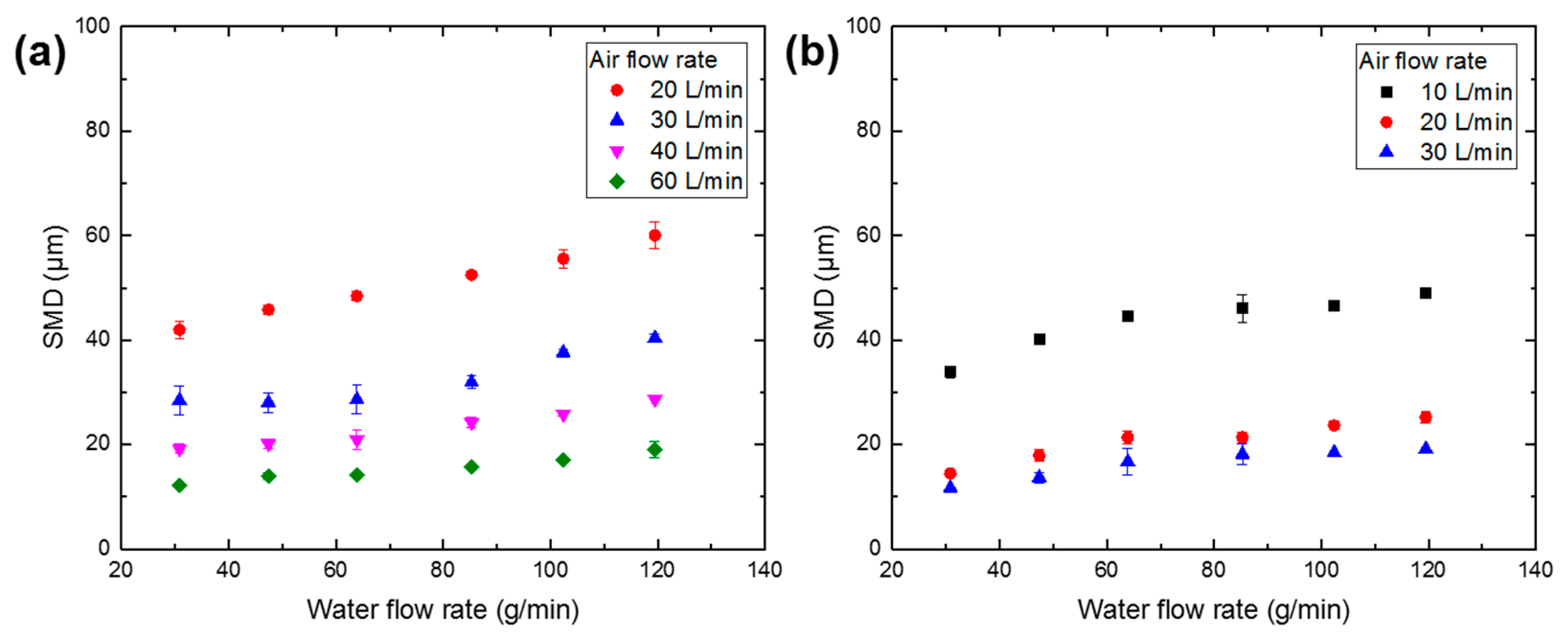
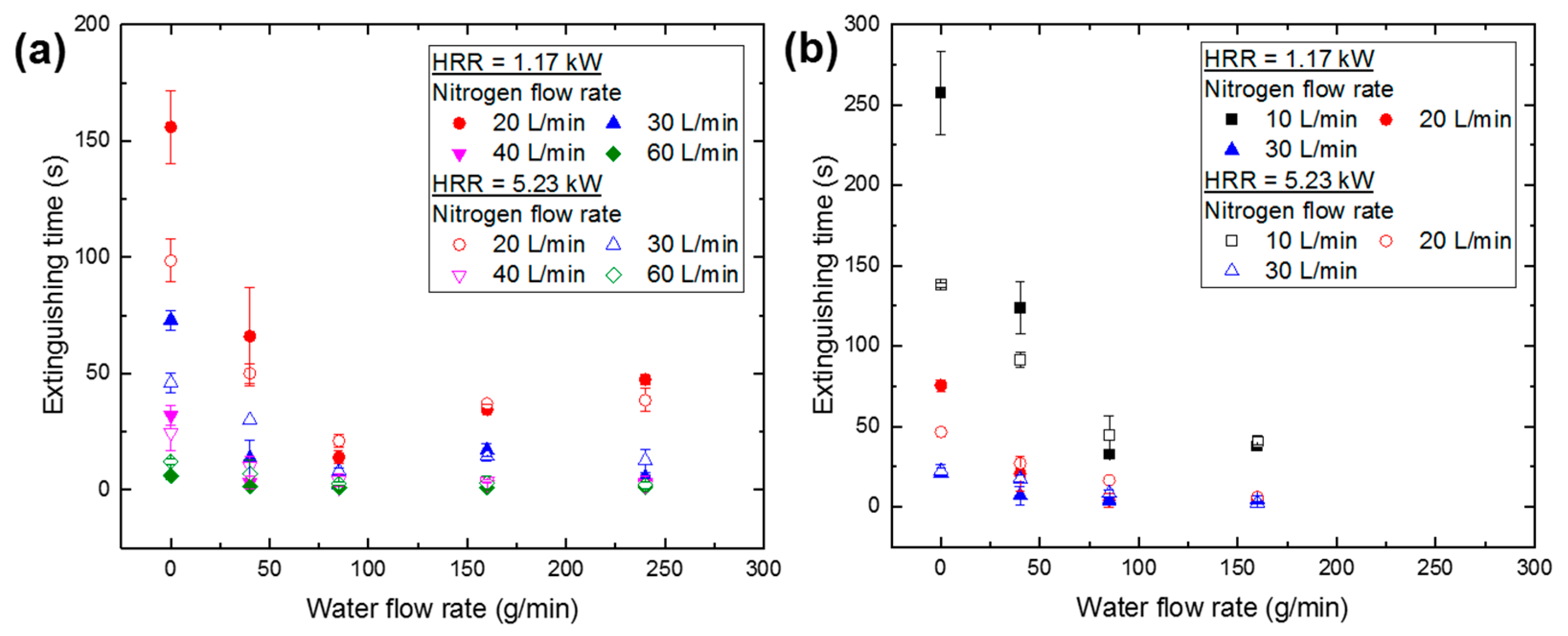
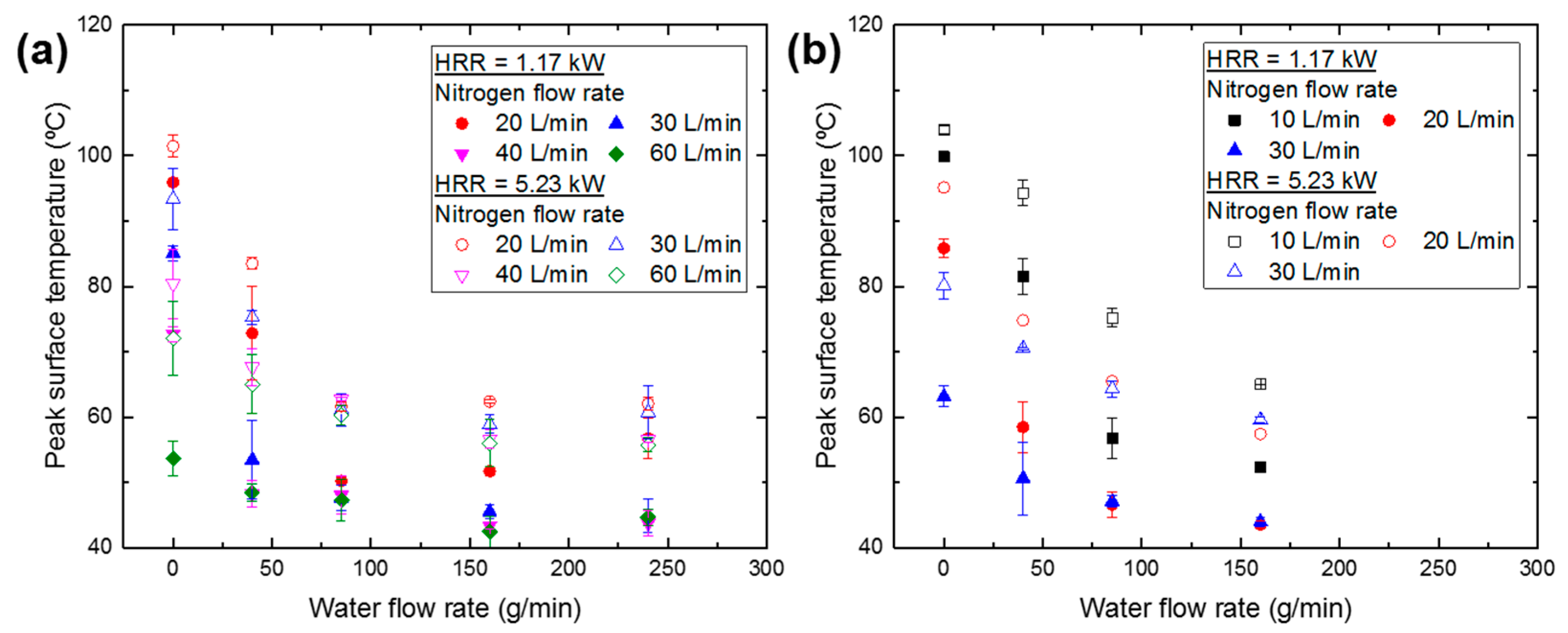
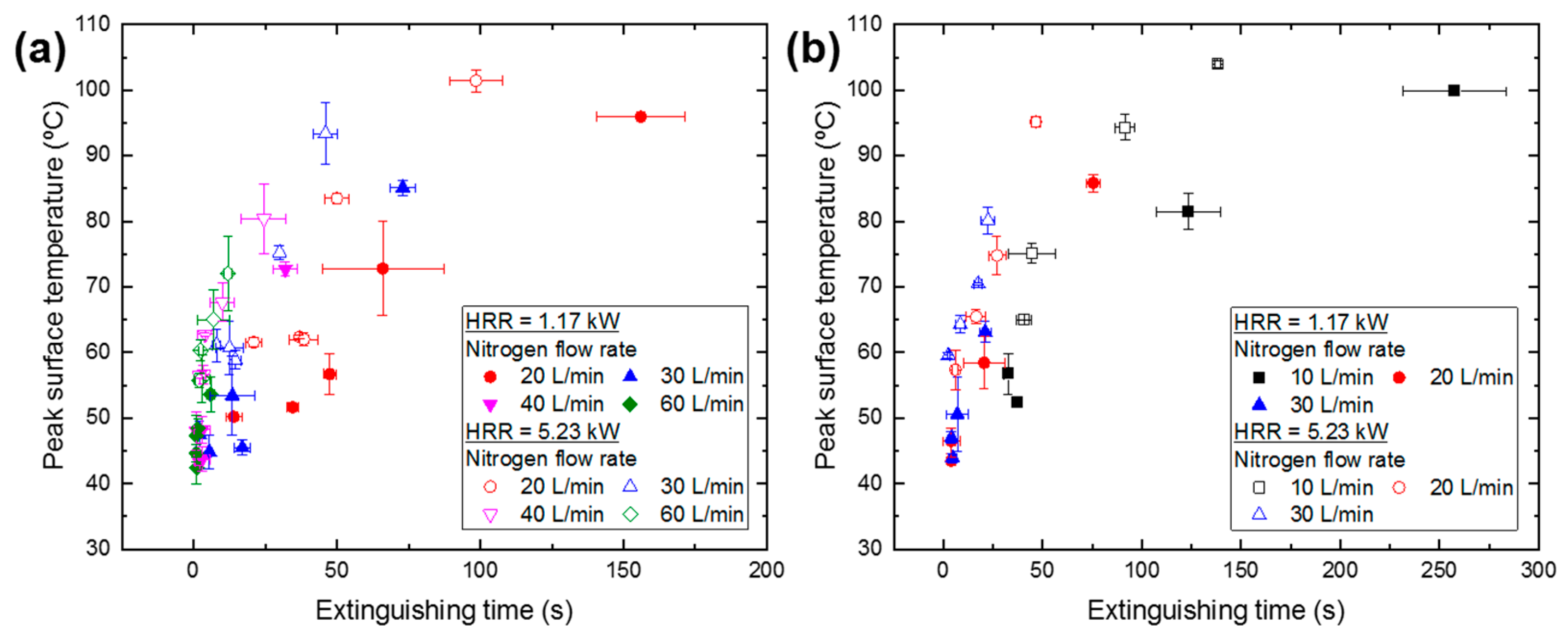
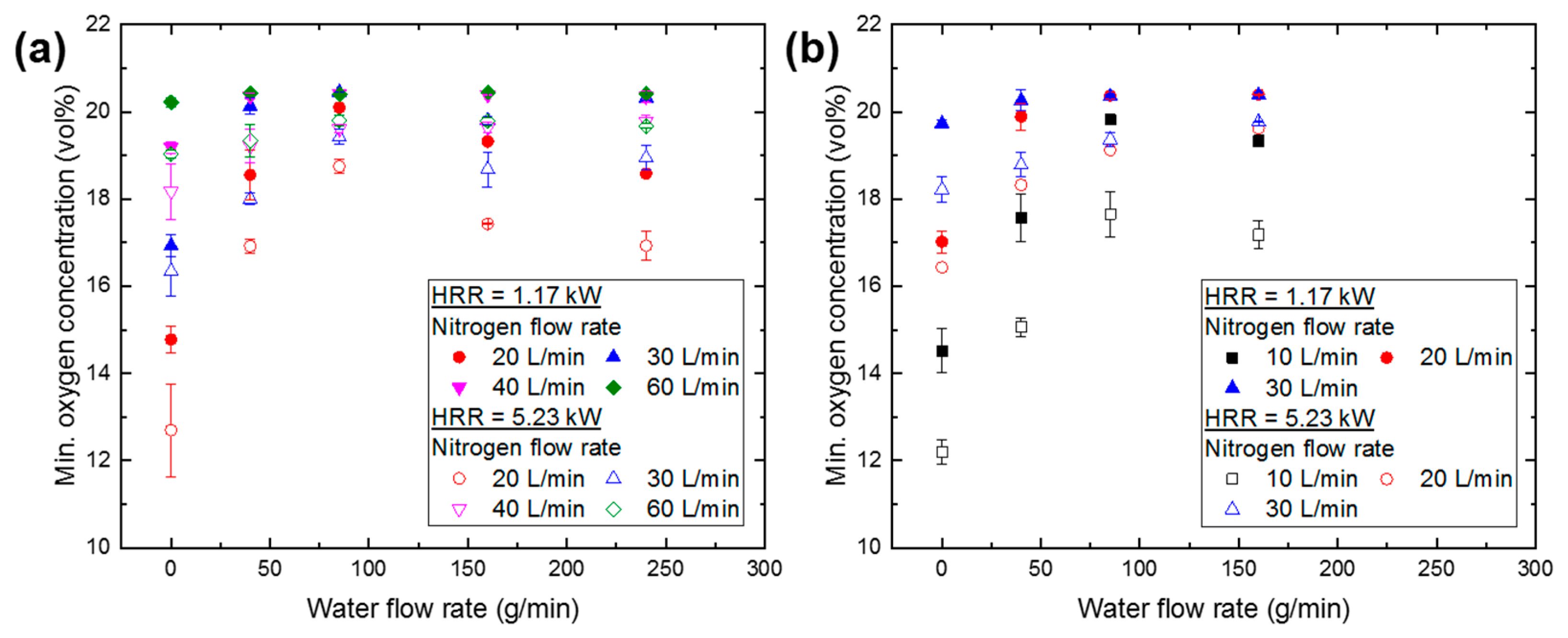
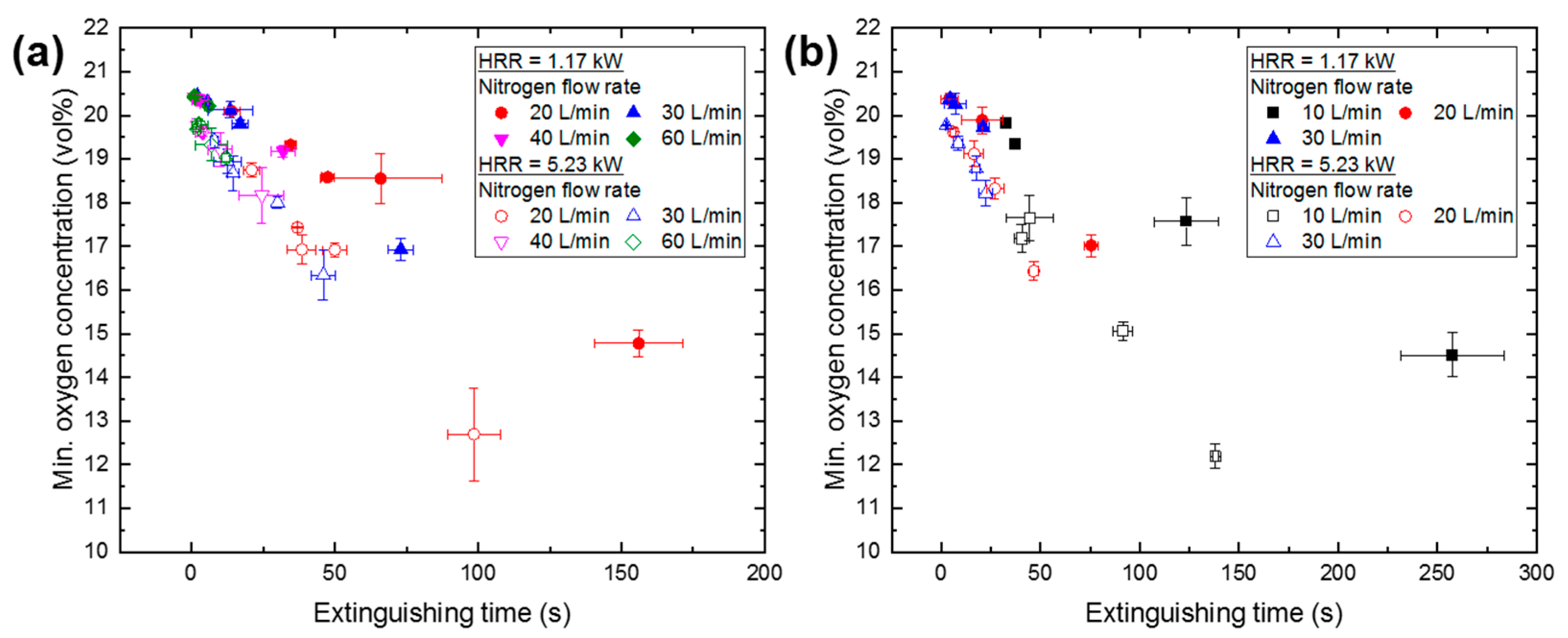



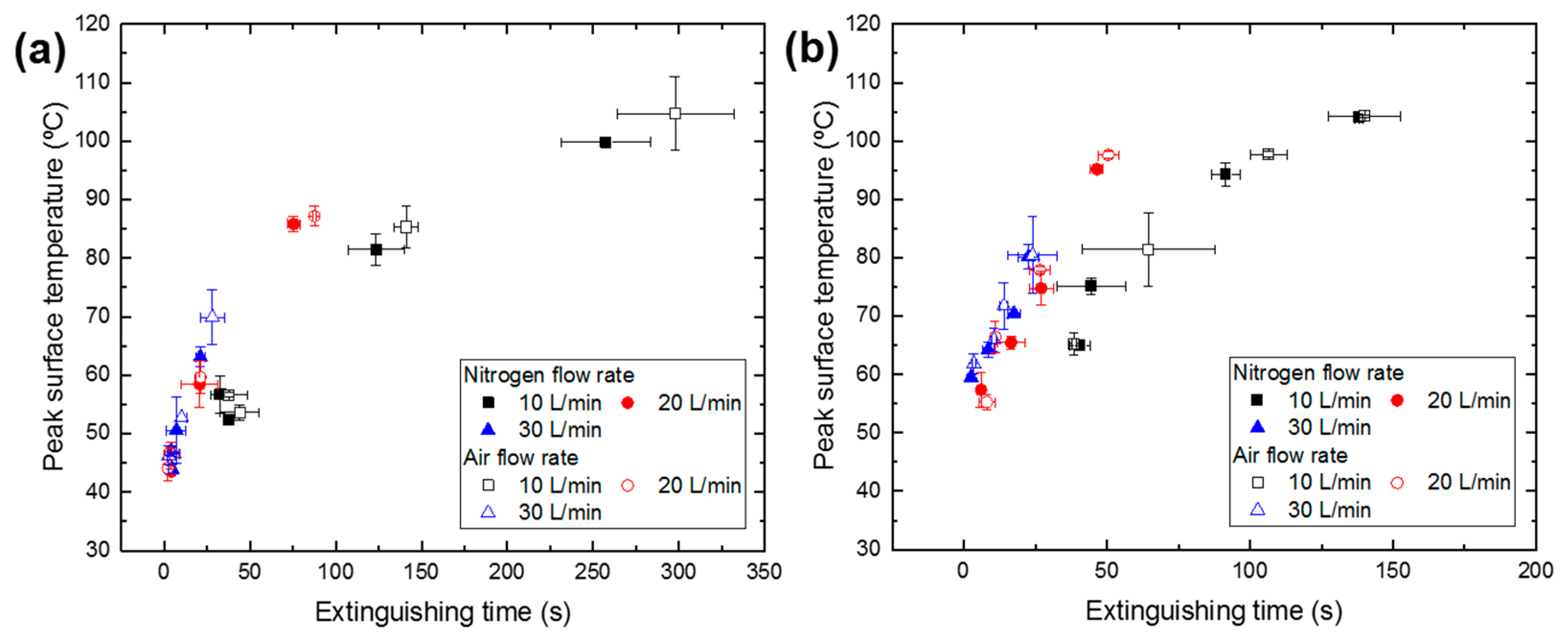


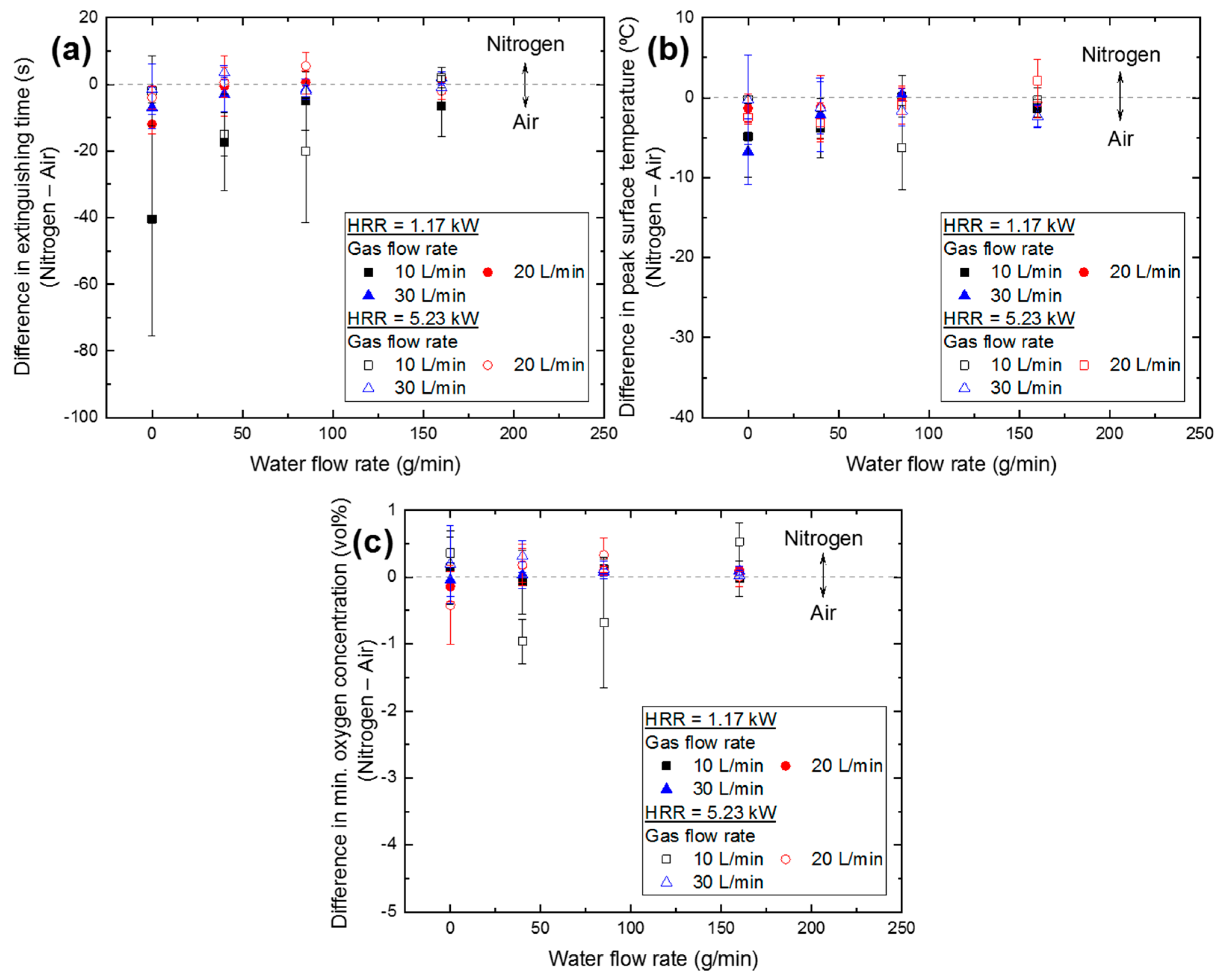
| Twin-Fluid Atomizer | Large Atomizer | Small Atomizer |
|---|---|---|
| Water Flow Rate (g/min) | 0, 40, 85, 160, 240 | 0, 40, 85, 160 |
| Nitrogen Flow Rate (L/min) | 20, 30, 40, 60 | 10, 20, 30 |
| Air Flow Rate (L/min) | — | 10, 20, 30 |
| Fuel | n-Heptane | |
| Fuel Volume (mL) | 100 | |
| Fuel Pan Diameter (mm) | 80 | 120 |
| Fuel Pan Height (mm) | 45 | 65 |
| Fuel Pool Depth (mm) | 20 | 9 |
| Mass Loss Rate (g/s) | 0.0285 | 0.1276 |
| Heat Release Rate (kW) | 1.17 | 5.23 |
Publisher’s Note: MDPI stays neutral with regard to jurisdictional claims in published maps and institutional affiliations. |
© 2021 by the authors. Licensee MDPI, Basel, Switzerland. This article is an open access article distributed under the terms and conditions of the Creative Commons Attribution (CC BY) license (https://creativecommons.org/licenses/by/4.0/).
Share and Cite
Kim, D.H.; Lee, C.Y.; Oh, C.B. Effects of Discharge Area and Atomizing Gas Type in Full Cone Twin-Fluid Atomizer on Extinguishing Performance of Heptane Pool Fire under Two Heat Release Rate Conditions in an Enclosed Chamber. Appl. Sci. 2021, 11, 3247. https://doi.org/10.3390/app11073247
Kim DH, Lee CY, Oh CB. Effects of Discharge Area and Atomizing Gas Type in Full Cone Twin-Fluid Atomizer on Extinguishing Performance of Heptane Pool Fire under Two Heat Release Rate Conditions in an Enclosed Chamber. Applied Sciences. 2021; 11(7):3247. https://doi.org/10.3390/app11073247
Chicago/Turabian StyleKim, Dong Hwan, Chi Young Lee, and Chang Bo Oh. 2021. "Effects of Discharge Area and Atomizing Gas Type in Full Cone Twin-Fluid Atomizer on Extinguishing Performance of Heptane Pool Fire under Two Heat Release Rate Conditions in an Enclosed Chamber" Applied Sciences 11, no. 7: 3247. https://doi.org/10.3390/app11073247
APA StyleKim, D. H., Lee, C. Y., & Oh, C. B. (2021). Effects of Discharge Area and Atomizing Gas Type in Full Cone Twin-Fluid Atomizer on Extinguishing Performance of Heptane Pool Fire under Two Heat Release Rate Conditions in an Enclosed Chamber. Applied Sciences, 11(7), 3247. https://doi.org/10.3390/app11073247





